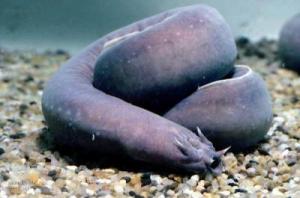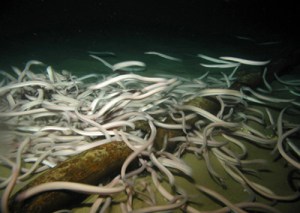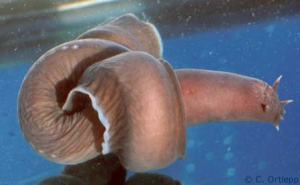
Hagfish, which is a group of organisms that make up the class Myxini which has about 70 extant species, are vertebrates that have a skull, but no jaws. They are strange and illuminating and wonderful organisms.
They are strange for a list of reasons so long it would take a book to fully explain them all. They are scavengers that live on the bottoms of the oceans all around the world from fairly shallow coasts to the abysses of the deep oceans. There they survive by eating whatever dead mater falls to the seabed. Most of the things that live in the ocean, and so most of the things that die on the ocean, are small. This means that Hagfish have to get by on little food for long periods of time, and tey are really good at it. Hagfish can live just fine for 6 months to a year without any food at all. Every once in a while, however, something big dies in the ocean, and I mean really big. When a whale dies, it sinks to the ocean floor and suddenly become a massive food resource in a part of the ocean that has very little to eat. Hagfish find these “whale falls” by using their incredible sense of smell. Their sense of smell is so good that they can smell a dead whale from something like a mile away! Once located, the Hagfish use their rasping tongue, which is equipped with hard and sharp “teeth” made of karitin (which is the same material that our fingernails are made of) to scrape through the

skin and muscle of the dead carcass and borrow into the body cavity where the hagfish then eat the carcass from the inside out. One dead whale can attract thousands of Hagfish (Image 2).
To get through the tough skin of a whale with no jaws is a bit of a problem. The hagfish solve this problem by tying themselves into knots. Yup, they use their

whole body to tie a knot that by sliding that knot forward, up their body they can use it to leverage their mouth against a carcass and rasp their way through. One thing that helps the slide that knot up their bodies is slime. Hagfish can secrete copious amounts of slime, and they can do it incredibly quickly. The slime has many functions. One is that it reduces friction and so lets a Hagfish knot its body more easily and also to slide that knot up towards it mouth to provide leverage. Another function is in predator defense. Hagfish don’t have jaws, they also do not have venom or spines or hard plates that might help them defend against an animal that is trying to eat them. Instead, they have their slime. When a Hagfish is attacked, or in distress for any other reason, it responds by secreting up to a gallon of slime in mere seconds. The would be attacker has the unpleasant experience of having its mouth filled with a mass of thick, gooey, mucusey, slime and not the Hagfish meal it was hoping for. Some of the videos of sharks attempting to eat Hagfish and getting slimed are amazing, a little funny, and also leave you feeling kind of bad for the shark as it has to then get all this slime out of its mouth.
Hagfish are illuminating because they allow us some views into vertebrate evolution and how they have diverged from other chordates. Because they have a a skull (like us and most other vertebrates), but no jaws (unlike us), they allow comparisons and observations into how jaws evolved, how fins evolved, and how the vertebrate skeleton as a whole evolved.
If, after reading this, you find Hagfish to be as interesting as I do, you will see why I included ‘wonderful’ in my introduction to these creatures. They are amazing animals that share our world and fascinate us and can teach us about where we came from. Pretty wonderful.
Hi,
I wander if you know the copyright owner of any of the images in this blog. I am writing a book on bloodsucking creatures, and need a pic or two of hagfish to include in the lamprey chapter. If you can help it would be very appreciated.
LikeLike
I am pretty sure I got these off of open access sites on the web. Not sure about who might hold the copyright. Sorry. I would be interested in seeing the book, when you are ready to share it with the world.
LikeLike